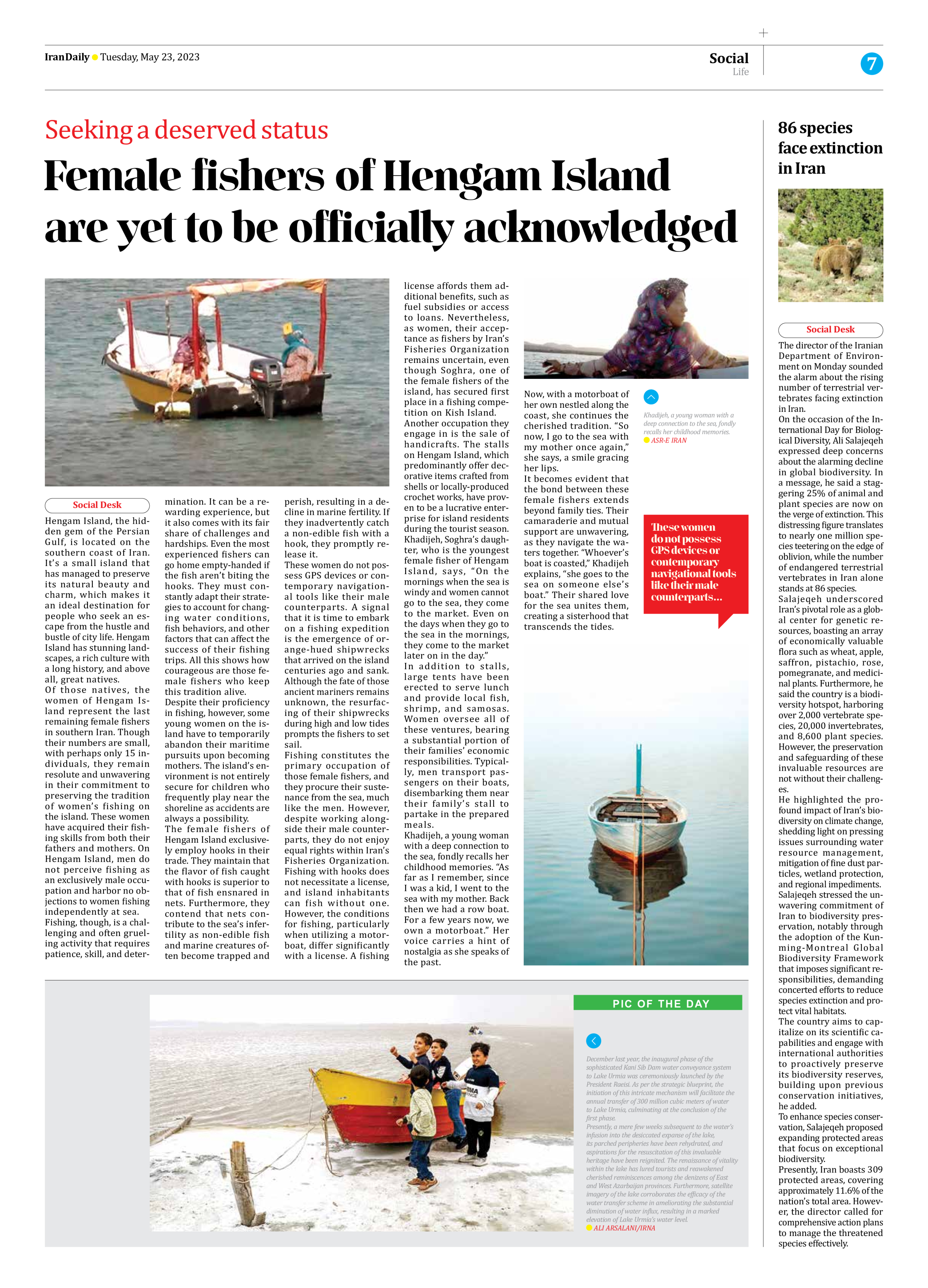
Seeking a deserved status
Female fishers of Hengam Island are yet to be officially acknowledged
Hengam Island, the hidden gem of the Persian Gulf, is located on the southern coast of Iran. It’s a small island that has managed to preserve its natural beauty and charm, which makes it an ideal destination for people who seek an escape from the hustle and bustle of city life. Hengam Island has stunning landscapes, a rich culture with a long history, and above all, great natives.
Of those natives, the women of Hengam Island represent the last remaining female fishers in southern Iran. Though their numbers are small, with perhaps only 15 individuals, they remain resolute and unwavering in their commitment to preserving the tradition of women’s fishing on the island. These women have acquired their fishing skills from both their fathers and mothers. On Hengam Island, men do not perceive fishing as an exclusively male occupation and harbor no objections to women fishing independently at sea.
Fishing, though, is a challenging and often grueling activity that requires patience, skill, and determination. It can be a rewarding experience, but it also comes with its fair share of challenges and hardships. Even the most experienced fishers can go home empty-handed if the fish aren’t biting the hooks. They must constantly adapt their strategies to account for changing water conditions, fish behaviors, and other factors that can affect the success of their fishing trips. All this shows how courageous are those female fishers who keep this tradition alive.
Despite their proficiency in fishing, however, some young women on the island have to temporarily abandon their maritime pursuits upon becoming mothers. The island’s environment is not entirely secure for children who frequently play near the shoreline as accidents are always a possibility.
The female fishers of Hengam Island exclusively employ hooks in their trade. They maintain that the flavor of fish caught with hooks is superior to that of fish ensnared in nets. Furthermore, they contend that nets contribute to the sea’s infertility as non-edible fish and marine creatures often become trapped and perish, resulting in a decline in marine fertility. If they inadvertently catch a non-edible fish with a hook, they promptly release it.
These women do not possess GPS devices or contemporary navigational tools like their male counterparts. A signal that it is time to embark on a fishing expedition is the emergence of orange-hued shipwrecks that arrived on the island centuries ago and sank. Although the fate of those ancient mariners remains unknown, the resurfacing of their shipwrecks during high and low tides prompts the fishers to set sail.
Fishing constitutes the primary occupation of those female fishers, and they procure their sustenance from the sea, much like the men. However, despite working alongside their male counterparts, they do not enjoy equal rights within Iran’s Fisheries Organization. Fishing with hooks does not necessitate a license, and island inhabitants can fish without one. However, the conditions for fishing, particularly when utilizing a motorboat, differ significantly with a license. A fishing license affords them additional benefits, such as fuel subsidies or access to loans. Nevertheless, as women, their acceptance as fishers by Iran’s Fisheries Organization remains uncertain, even though Soghra, one of the female fishers of the island, has secured first place in a fishing competition on Kish Island.
Another occupation they engage in is the sale of handicrafts. The stalls on Hengam Island, which predominantly offer decorative items crafted from shells or locally-produced crochet works, have proven to be a lucrative enterprise for island residents during the tourist season.
Khadijeh, Soghra’s daughter, who is the youngest female fisher of Hengam Island, says, “On the mornings when the sea is windy and women cannot go to the sea, they come to the market. Even on the days when they go to the sea in the mornings, they come to the market later on in the day.”
In addition to stalls, large tents have been erected to serve lunch and provide local fish, shrimp, and samosas. Women oversee all of these ventures, bearing a substantial portion of their families’ economic responsibilities. Typically, men transport passengers on their boats, disembarking them near their family’s stall to partake in the prepared meals.
Khadijeh, a young woman with a deep connection to the sea, fondly recalls her childhood memories. “As far as I remember, since I was a kid, I went to the sea with my mother. Back then we had a row boat. For a few years now, we own a motorboat.” Her voice carries a hint of nostalgia as she speaks of the past.
Now, with a motorboat of her own nestled along the coast, she continues the cherished tradition. “So now, I go to the sea with my mother once again,” she says, a smile gracing her lips.
It becomes evident that the bond between these female fishers extends beyond family ties. Their camaraderie and mutual support are unwavering, as they navigate the waters together. “Whoever’s boat is coasted,” Khadijeh explains, “she goes to the sea on someone else’s boat.” Their shared love for the sea unites them, creating a sisterhood that transcends the tides.







